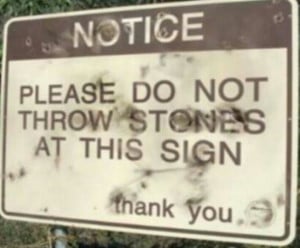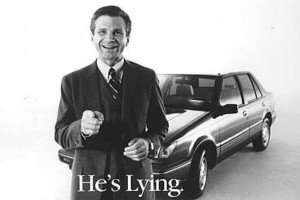 It’s called “reactance.”
It’s called “reactance.”
When someone tries to tell you what to think or do — that automatic resistance you feel is called reactance by psychologists.
And for advertisers, there are plenty of work-arounds for reactance:
- You can dramatize your points within a story
- You can demonstrate your points rather than claiming them
- You can flatter the audience rather than bragging to them
- You can use humor to disarm an audience’s reactance
- You can let the audience connect the dots rather than explicitly making a claim
These are all solid tools for sidestepping and overcoming reactance.
But you can also use a little bit of psychological jiu jitsu to make reactance work in your favor.
Enter Reverse Psychology.
The most obvious and straightforward way to do this is what I’d call the “don’t think of a white bear” approach.

By telling you NOT to buy the jacket, Patagonia is making your resistance work in their favor.
You see the ad, and now you sort of want the jacket, just due to reactance.
Plus the unexpected headline really grabs attention and ensures the ad breaks through the clutter.
Even better, Patagonia gets the added bonus of demonstrating their commitment to sustainable, eco-friendly business practices.
But there’s actually a more sophisticated approach to reverse psychology, that I think works much better.
In VW’s ad, they present an over-the-top challenge that makes you say “no, way.”
And then they show that they fail at the no way challenge. Your initial reactance has been spent and rewarded.
So when the still-impressive-but-not-outrageous claim gets made, you readily accept it.
If you were worried about headroom or leg room in a VW, you’re now comfortable that as long as you are “only” six foot six, you’ll be fine.
Hey, there’s a reason why the boys and gals at BBDO are widely credited with ushering in the creative revolution in advertising.
Stacking Reverse Psychology with Storytelling & Humor
 Of course, if you really want to see reverse psychology in action, you can’t do better than the Joe Isuzu campaign.
Of course, if you really want to see reverse psychology in action, you can’t do better than the Joe Isuzu campaign.
Because like most messaging strategies, reverse psychology works better when stacked with storytelling and character-driven campaigns.
Created by Della Femina, Travisano, and Partners, the Joe Isuzu campaign launched in 1986 with an ad budget that was less than a tenth of Toyotas.
So how do you grab a disproportionate share of mind with a tiny budget?
You create ads that zig when others zag.
Ads that do something provocative, shocking, or intriguing enough to be un-ignorable.
And if you’re really good, you do it in a way that’s inherently likable.
Enter Joe Isuzu.
The Joe Isuzu Campaign: Making Big Things Happen with a Small Budget
With his plastered-on smile and smarmy demeanor, Joe was a hyperbolic, amusing send-up of the shady car salesman cliche.
Everything out of Joe’s mouth was not only a lie, but an outrageous whopper.
And here’s the genius in this concept:
Isuzu’s actual brand voice applied the self-correcting subtitles below Joe’s whoppers.
So Joe asserts that the Isuzu Trooper “has more seats than the Astrodome,” while the subtext notes: “Almost. It Seats Five.”
And when Joe claims an Isuzu is “So inexpensive, you can buy one with your spare change,” the subtext corrects with: “If you have $6,189 in quarters.”
This dazzling co-presentation of text and subtext allows these Joe Isuzu ads to jiu-jitsu your reactance.
By overlaying the brand’s authentic voice as a counter to Joe Isuzu’s lies, the ads put you, the viewer, in on the joke.
Even better, the dishonest Joe Isuzu presents as the polar opposite of the actual straight-talking, almost self-deprecating-by-comparison brand whom you can’t help but like and trust.
A Cultural Icon that Spiked Sales — For Awhile At Least…
Did it work?
Hell, yeah, it worked!
Sales spiked 18% within the first year of the campaign, while Isuzu was effectively put on the map of America’s collective conscious.
Joe Isuzu instantly rocketed to pop culture icon status.
He was twice referenced by 80’s politicians, once by Reagan and once by Dukakis, with the latter using him as a Presidential Debate punchline:
“If George H. Bush keeps it up, he’s going to be the Joe Isuzu of American politics”
Talk about share of mind!
Not bad for a tiny ad budget used to promote a then-unknown Asian import.
Unfortunately, in the longer run, Isuzu couldn’t overcome challenges with product design, dealer network support, and myriad other business realities that tanked their ability to compete with the big dogs.
Advertising can only accelerate success. It can’t make success live where it does not deserve to live.
But… the campaign itself worked as intended. Better than anyone could have dreamed, in fact.
So if you have what it takes to be a success, and you’d like to make big things happen fast on a smaller budget than your competition…
Consider hiring ad creatives who understand powerful, persuasive branding.
- What Digital Superstars Know About Offline Advertising - November 17, 2025
- Unmistakable: A Tale of Two Boots and Branding Done Right - November 8, 2025
- Making the Branding Math *Math* with Broadcast Radio - October 30, 2025
